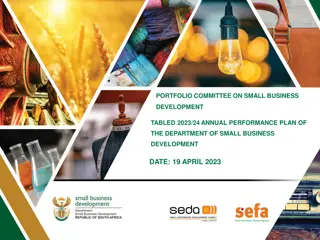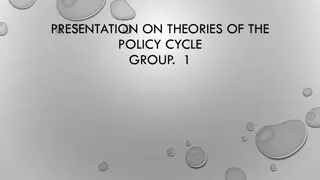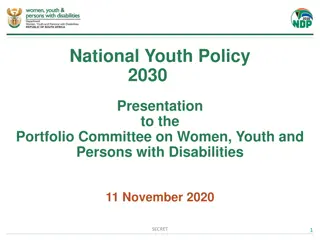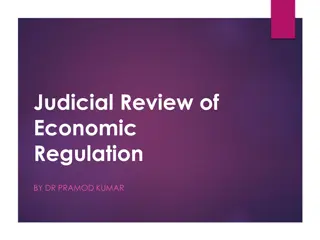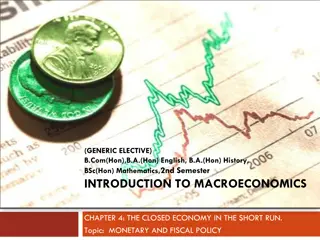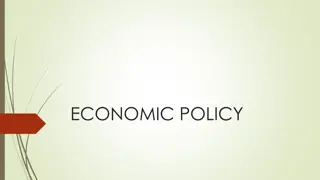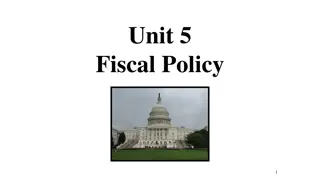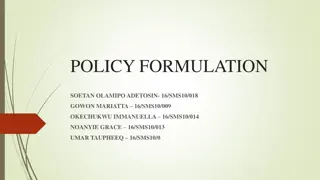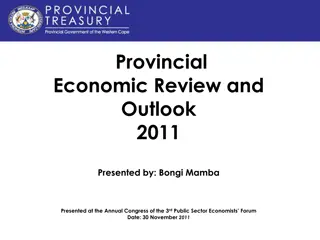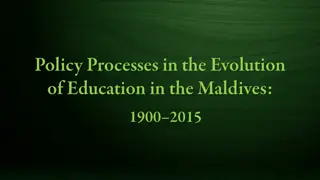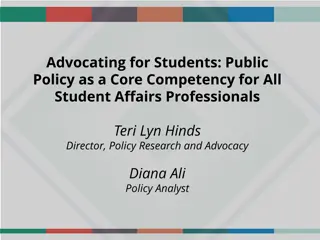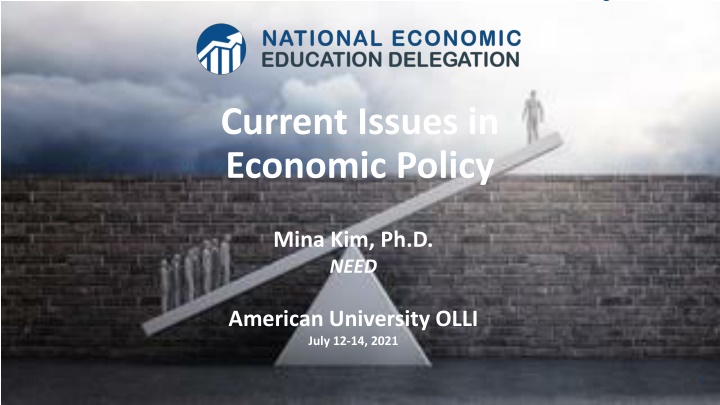
Current Economic Policy Issues
Public discussion, economic principles, advocacy, and presentations by NEDE on economic policy issues, global partnerships, and economic inequality analysis, as well as solutions and perceptions on the matter.
Download Presentation

Please find below an Image/Link to download the presentation.
The content on the website is provided AS IS for your information and personal use only. It may not be sold, licensed, or shared on other websites without obtaining consent from the author. If you encounter any issues during the download, it is possible that the publisher has removed the file from their server.
You are allowed to download the files provided on this website for personal or commercial use, subject to the condition that they are used lawfully. All files are the property of their respective owners.
The content on the website is provided AS IS for your information and personal use only. It may not be sold, licensed, or shared on other websites without obtaining consent from the author.
E N D
Presentation Transcript
Current Issues in Economic Policy Mina Kim, Ph.D. NEED American University OLLI July 12-14, 2021 1
National Economic Education Delegation Vision - One day, the public discussion of policy issues will be grounded in an accurate perception of the underlying economic principles and data. Mission - NEED unites the skills and knowledge of a vast network of professional economists to promote understanding of the economics of policy issues in the United States. NEED Presentations - Are nonpartisan and intended to reflect the consensus of the economics profession. 2
Who Are We? Honorary Board: 47 members - 2 Fed Chairs: Janet Yellen, Ben Bernanke - 6 Chairs Council of Economic Advisers o Furman (D), Rosen (R), Bernanke (R), Yellen (D), Tyson (D), Goolsbee (D) - 3 Nobel Prize Winners o Akerlof, Smith, Maskin Delegates: 500+ members - At all levels of academia and some in government service - All have a Ph.D. in economics - Crowdsource slide decks - Give presentations Global Partners: 45 Ph.D. Economists - Aid in slide deck development 3
Credits and Disclaimer This slide deck was authored by: - Jon Haveman, Executive Director of NEED This slide deck was reviewed by: - Timothy Smeeding, University of Wisconsin - Robert Wright, Augustana University Disclaimer - NEED presentations are designed to be nonpartisan - It is, however, inevitable that the presenter will be asked for and will provide their own views - Such views are those of the presenter and not necessarily those of the National Economic Education Delegation (NEED) 5
Poll There is Too much The right amount Too little economic inequality in the country these days. If you answered that there is too much economic inequality, of economic inequality is acceptable. Some amount No amount 7
Outline Definition Measurement How does it happen? Does it matter? Is it a problem? What to do about it 8
Economic Inequality Definition: - The extent to which the distribution of people s economic position deviates from complete equality - The dispersion of people s economic positions. 9
Different Ways of Thinking About Inequality Income Inequality - Before taxes and transfers - After taxes and transfers Wealth Inequality Consumption Inequality 10
Different Ways of Thinking About Inequality Income Inequality - Before taxes and transfers - After taxes and transfers Wealth Inequality Consumption Inequality Inequality of Opportunity 11
National Income Inequality: Share of Top 10% Stock Market Crash WWII Housing Bubble Dot-com Bubble 12
The Abrupt Increase in Inequality 15 Source: Chad Stone, Danilo Trisi, Arloc Sherman, and Roderick Taylor, A Guide to Statistics on Historical Trends in Income Inequality, Center on Budget and Policy Priorities, Policy Futures, Dec. 11, 2018.
Disappearing Middle Class In this report, middle income households are defined as those with an income that is 67% to 200% (two thirds to double) of the overall median household income, after incomes have been adjusted for household size. 18
Wealth Inequality Exceeds Income Inequality 19 Source: Chad Stone, Danilo Trisi, Arloc Sherman, and Roderick Taylor, A Guide to Statistics on Historical Trends in Income Inequality, Center on Budget and Policy Priorities, Policy Futures, Dec. 11, 2018.
A Third Measure of Inequality: Consumption Inequality Consumption is another important metric for judging inequality Arguably a better indicator of well-being Extremely difficult to measure Growing evidence that consumption inequality has also increased 21
Summary: Consumption Inequality Early research indicated that although income inequality may be increasing, consumption inequality may not be. - How is this possible? Borrowing, or otherwise smoothing consumption. Mounting evidence that it is increasing along with income and wealth inequality. Consensus reached? No. 23
U.S. 24 https://equitablegrowth.org/research-paper/are-todays-inequalities-limiting-tomorrows-opportunities
Poll Which factors are essential for being economically successful in the US today? Hard work Knowing the right people Graduating from college Graduating from a highly ranked college Graduating from professional school Having well-educated parents Coming from an upper-income family Growing up in an upper-income neighborhood A person s racial/ethnic background 26
Upward Mobility: Finances Matter High math-ability 3rd graders much more likely to become inventors if their family is well-off. (Also if they grow up in high- innovation areas) 27
The Geography of Upward Mobility in the United States Average Individual Income for Males with Parents Earning $25,000 (25th percentile) Newark $30.1k San Francisco Bay Area $28.8k 56.9 ($34.5k) Atlanta $23.1k 49.0 ($27.6k) 42.9 ($22.8k) Source: Chetty et al. Note: Green = More Upward Mobility, Red = Less Upward Mobility
U.S. racial differences Odds of staying poor, if born poor Odds of becoming poor, if born rich 29 Economic Policy Institute, State of Working America, 2012
Inequality of Opportunity It occurs when people living in the same society do not have access to the same opportunities. Outcomes that are valued by all or most members of society (such as income, wealth, health status, etc.) are determined by two types of factors: those for which the individual can be held responsible, and those for which they cannot (e.g. gender, place of birth, ethnicity, or parental background). Inequality of opportunity is thus widely regarded as the unfair part of inequality 30
Poll What do you think are the top three contributors to economic inequality? Outsourcing of jobs to other countries The tax system Problems with the education system The different life choices people make Some people start out with more opportunities than others Not enough regulation of major corporations Some people work harder than others Discrimination against racial and ethnic minorities The automation of jobs Current US trade policies Immigration Too much regulation of major corporations 32
Where Does Inequality Come From? Labor Characteristics - Demographics o Age distribution - Personal Choices o Educational attainment o Effort o Priorities o Household composition - Immigration Market Forces - Technology - Changing demand patterns - Competition for labor Government Policy - Market influence - Redistribution
Government Policy and Inequality Market Influence: PRE- distribution - Characteristics of labor o Access to education - Effects on labor demand o Market regulation Competition policy o Labor regulations Minimum wage, overtime, health insurance, etc. RE-distribution - Tax Rates - Income support o Direct aid o Food stamps 34
Taxes, Transfers, and Income: 2016 35 Source: U.S. Congressional Budget Office, The Distribution of Household Income, 2016 .
Government Policy and Racial Inequality Product of a long historical process of discrimination with at least two reinforcing sets of policies. - Policies that govern the spatial distribution of the black population. o Restrictive covenants, redlining, and general housing and lending discrimination - Policies that have a disparate impact on black individuals because of their locations. o The original version of Michigan Senate Bill 897 exempted individuals from this work requirement conditional on residing in a county with an unemployment rate above 8.5 percent. The higher unemployment rates in rural counties would disproportionately exempt white Medicaid recipients from the work requirement within the bill. 36
Market Forces and Inequality Changing demand patterns - Technology - Globalization - Industry composition o PCs instead of typewriters o Services instead of goods o Professional services instead of personal services Competition in labor markets - Unionization - Market concentration 37
Technological Change and Inequality Much of the technology adopted in the last 30 years has eliminated low-skill or low-wage jobs. - Computers, advanced manufacturing equipment, steel mini-mills, automation There is a winner take all aspect of the technology-driven economy. - This likely favors a small group of individuals. Both aspects increase inequality by increasing the rewards to: - Those with significant labor market skills. - Owners over workers 38
Technology can Hurt Low Income Workers Early on, technology was good to low income workers Until it was bad for them . 39
Globalization What is globalization? - Flow of goods, services, capital, and labor across international borders How does it affect inequality? - Through a differential impact on low-skilled workers and hence their wages - For the United States, globalization is thought to lower the wages of low skilled and hence low-wage workers relative to those of high-skilled workers 40
Mechanisms for the Effects of Globalization Merchandise trade - Importing goods that are made with low-skilled workers and exporting goods that are made with high-skilled workers o Lowers the wages of unskilled relative to skilled making the distribution of income less equal Outsourcing - Similar channel as with merchandise trade Trade in services - US imports of middle-skill services: business and some professional services Intuitively: The same as if we were to move the actual workers. 41
Immigration and Inequality- Summary Beginning in about 1970, the immigrant share of the U.S. Population increased dramatically. - 5% in 1970 and 14% in 2016 Immigration tends to happen most often among: - Low-skilled low-wage workers - High-skilled high-wage workers Immigration has likely increased income inequality. Its effect has likely been small. - ~5% between 1980 and 2000 - No reason to think it has been bigger since 42
Declining Unionization Unionization Rates 1983: 2018: 20.1% 10.5% Unionization Rates Public: 33.9% Private: 6.4% 43 Source: Jason Furman, Forms and sources of inequality in the United States , VOX, March 17, 2016, Figure 4.
Competition in the Economy Return on invested capital excluding goodwill US publicly-traded nonfinancial firms, 1965-2014 44 Source: Jason Furman, Forms and sources of inequality in the United States , VOX, March 17, 2016, Figure 6.
Growing Revenue Concentration 45 Source: Furman and Orszag, A Firm-Level Perspective on the Role of Rents in the Rise in Inequality , 2015.
Addressing Inequality: Is It A Problem? Why it might be a problem. - Economic issues (Efficiency) o There is evidence that at some level, increased inequality slows economic growth. o Or, inequality concentrates resources among investors. - Noneconomic issues (Equity) o Values, ethics and morals will drive individual evaluations of the level of inequality. E.g., inequality is primarily a function of market outcomes, so should be left alone. Or, a solid middle class is important for maintaining a civil society, which runs contrary to a high degree of inequality. Suppose you think it s a problem. How might it be addressed? 46
Addressing Inequality: Immediately Available Policy Solutions (1/2) RE-distribution - Tax and transfer programs PRE-distribution - Strengthen labor unions - Collective bargaining - Other policies that favor labor over business owners - Minimum wages - Anti-discrimination
Addressing Inequality: Immediately Available Policy Solutions (2/2) Other - Reverse trends in market power Locally - Employment services: job training, interview skills, or assistance with day-to- day issues, such as child care - Cognizance of the potential for technologies to affect worker/employer power dynamics o Uber, Lyft, etc.
Addressing Inequality: Long Term It s all about access to resources: - Education, in particular o Improve public education o Reduce disparities in quality of public education o Improve counseling in low-income schools With respect to college paths to success and funding o Investments are needed in early education, not later (e.g. universal pre-k) - Opportunities for wealth-building - Housing Initiatives whose impacts cross neighborhood and class lines and increase upward mobility specifically for black men - Mentoring programs for black boys, efforts to reduce racial bias among whites, interventions to reduce discrimination in criminal justice, and efforts to facilitate greater interaction across racial groups.
Tension in Policy Solutions Is it possible to increase growth at the same time that you reduce income inequality? - Common refrain among some that government intervention in the economy is always and everywhere bad for growth. Possibly: expanding equality of access promotes the full utilization of resources. - Expanding equality of access requires resources likely from the well-to-do. 50


